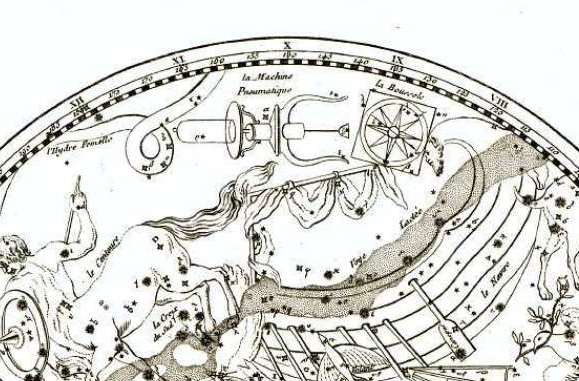Among the 88 constellations officially accepted by the International Astronomical Union, there are four dozen so-called new constellations, identified already in the era following the Great geographical discoveries. Their names, respectively, reflect the realities that are important for the 17th and 18th centuries, related to the development of technology and improvements to navigation and navigation facilities. The small southern constellation Pump (in Latin - Antlia, in abbreviated form - Ant) belongs to the number of precisely such sections of the celestial sphere.
General characteristics and position in the sky
The constellation covers an area of approximately 239 square degrees. Its structure includes many rather dim stars. About twenty of them have a gloss above 6 m and can be distinguished with the naked eye. The brightest luminaries make up a recognizable configuration - a quadrangle oriented with a narrow part to the north, towards Hydra - the largest constellation of the sky. Also in the vicinity of the Pump are Centaurus, Sails and Compass.
The pump is a constellation of the Southern Hemisphere and in the northern sky is available for observations, which are best done in February, only at latitudes below 51 °.
Constellation history
A group of stars with this name appeared on the sky map in 1754 thanks to the French astronomer and mathematician N. Lacaille. Therefore, no ancient legend is associated with the constellation Pump, but it has an interesting history.
Initially, Lacaille gave the constellation the name "Pneumatic Machine" (French Machine Pneumatique). At the same time, he did not mean any resemblance to the technical device, but, most likely, wanted to perpetuate one of the achievements of the New Time technique. Then the name was changed to “Air Pump” and Latinized (Antlia Pneumatica), and later reduced to a modern form. It is believed that Lacaille dedicated a new constellation to R. Boyle, who made significant improvements to the design of the air pump. However, the figure of the astronomer, published in 1756, apparently depicts the centrifugal pump of D. Papen, so it remains to be wondered who exactly inspired the scientist to this unusual name.

In the 19th century, constellations began to be understood as clearly limited areas of the sky, not groups of stars, and also reduced their number in order to reduce confusion. Further, in 1922, the boundaries of modern constellations were finally established. Unlike many others, the constellation Pump has survived all the "organizational turmoil" and preserved on star maps.
Noteworthy stars
The brightest star of this constellation is Alpha Pump, an orange giant, the distance to which is estimated at 320-370 light years. The brightness of this variable ranges from 4.22 m to 4.29 m . It is located at the apex of the blunt corner of the quadrangle characteristic of the constellation figure. Two sharp southern peaks are the stars Iota and Epsilon Pump, giants of the same spectral class K.
To the north of the Epsilon star - above the right corner of the triangle - the triple Zeta Pump system is available for viewing through binoculars. Binoculars can also be used to see the most interesting object in the southern part of the constellation - the red giant U Pump, which is a carbon star that lives its life. This luminary at a late stage of evolution, has already thrown off the outer shell. The presence of a very fine gas structure around the U Pump was detected in 2017 using the ALMA telescope.
Exoplanets
There are several stars in the constellation Pump for which the presence of planets is established. To date, five such facilities have been opened.
Four planets - HATS-19 b, HATS-26 b, HATS-64 b and WASP-66 b - are very close to their suns, have orbital periods from 3 to 5 Earth days and are therefore extremely hot. By mass, they are comparable with Jupiter and Saturn. The fifth known planet orbiting the star HD 93083 has a much longer period - about 144 days - but still it is too hot and also does not fall into the habitable zone of its parent star. It is possible that any stars in the Pump (including those listed) also have low-mass planets located in more distant orbits. Is this so, further research will show.
Deep space phenomena
The area occupied by the constellation Pump in the sky also contains objects located outside our Milky Way galaxy. First of all, it is a beautiful spiral galaxy NGC 2997, which has a compact but very bright core and a jumper and with distinct giant clouds formed by ionized hydrogen with a temperature of about 10 thousand degrees.
In addition, there are two dwarf galaxies belonging to the Local Group: Antalya, or PGC 29194, and the satellite of our Milky Way Antalya 2. This extremely dispersed, dim, so-called ultra-diffuse object was discovered recently, in November 2018, using Gaia Space Telescope.
Of course, when viewed with the naked eye, the constellation Pump is unlikely to appear spectacular to the observer. However, due to the presence in it of a number of interesting stars and galaxies, astronomy lovers do not bypass this area of the southern sky with a somewhat strange at first glance name.